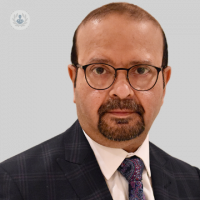Patient-tailored minimally invasive treatment for BPH
Written in association with:1 in 3 men over 50 will have enlargement of the prostate which can cause bladder outflow obstruction, and give rise to urinary symptoms. This is known as benign prostatic hyperplasia or BPH. We asked leading urologist Mr Aniruddha Chakravarti about this condition and the modern minimally invasive options for treating it.


How does BPH affect patients?
Effects on patients include:
- Discomfort with urinary symptoms of slow flow, sense of not being able to empty bladder, needing to urinate frequently and getting up at night
- Interference with daily activities
- Sexual dysfunction
- Worry about what’s going to happen in the future
- An impact on physical and mental health – they often get up at night and don’t get enough sleep.
- An impact on personal relationships
We know that BPH is a progressive condition. This progression raises the prospect of additional adverse impact on quality of life as the symptoms worsen, the risk of urine retention, and the need for surgery.
Men can be often unhappy with the drugs available because of side-effects which can impact on their quality of life and sexual function. They’re not happy being long-term dependent on drugs.
What do BPH patients want?
They want a treatment that gives them:
- Rapid and lasting relief from their symptoms
- A better quality of life
- A solution that carries the lowest risk, with no or minimal side-effects.
Men of all ages also want to preserve sexual function.
When it comes to treating BPH, what are the minimally invasive treatment options?
Treatment evolved from open surgery to minimally invasive options a long time ago.
TURP
The first that became widely used was TURP (transurethral resection of the prostate), which was invented over 50 years ago. While it is great improvement compared with open surgery, it has its limitations:
- Because we are resecting the prostate from inside, we may not be able to remove the whole adenoma (enlarged part of the prostate), depending on the size.
- It is time-limited – if you spend more than an hour on a TURP, the patient’s risk of fluid absorption increases. The fluid commonly used in monopolar TURP is glycine, which is toxic to the body when absorbed.
- Moderate risk of bleeding
- Risk of erectile dysfunction is also about 10-15%, possibly more. The risk is unpredictable because the effect of an electric current on tissues is unpredictable considering depth of penetration, which can affect the nerves that control erections. Often these patients will need a reoperation in 10 years’ time due to regrowth of tissue.
Due to these limitations, it is less suitable for larger prostate volumes.
Laser enucleation of the prostate
There have been advancements in BPH treatment with the trials of several types of lasers. Laser energy is much more precise, controllable, and predictable than electrical currents, improving surgical precision.
Of the laser therapies that have been tried for BPH, laser enucleation of the prostate has been the most successful. This treatment:
- Is predictable
- Provides long-lasting relief of 20-25 years
- Can be done for any size of prostate
- Uses saline rather than glycine, therefore there is no risk if it is absorbed
- Takes a larger amount of tissue for analysis
- Has much superior de-obstruction rates after removal of obstructing prostate tissue when compared with other techniques.
When we compare this treatment (according to published studies) with other treatments like laser coagulation, TURP, etc., this treatment has the best results for high-risk patients who have chronic urinary retention, with poor bladder function and very large prostates. Therefore, this treatment, which can be done with Holmium or Thulium laser, stands out above all the other treatments available.
The most commonly used modality is the Holmium laser, which is more predictable and has very little penetration of just 2mm. Therefore, the chance of impotence and incontinence are very low (compared to other options).
More recent minimally invasive options
We can offer tailor-made treatments using new technology like Urolift. This involves putting some implants into the prostate as a day case. It is often possible under local anaesthetic. 70% of cases avoid the need for a catheter and there is no or minimal bleeding, no cutting or burning of the prostate, so there is no sexual dysfunction and continence is completely preserved. This improves their flow and their symptoms and gives them relief for a reasonable length of time.
However, this treatment is not yet suitable for all groups of patients. The success of this procedure is not yet proven for very large prostates and prostates of certain anatomical configuration with a large part or parts of the prostate prolapsing into the bladder.
For those who are higher risk, for example people with chronic retention, poor bladder function, and very large prostates, are best served by Holmium laser enucleation of the prostate (HoLEP). This solution is much more effective and much longer-lasting; however it carries a very small risk of sexual dysfunction, and a risk of incontinence of less than 1%.
According to the size and shape of the prostate, the personal needs of the patient, their age, their lifestyle, and the severity of their condition, we can offer a tailor-made solution for every individual that would be rapid, long-lasting, and minimally invasive, with minimal possible side-effects. This enables the patient to improve their quality of life greatly without any dependence on drugs long term.
Visit Mr Chakravarti’s Top Doctors profile to book an appointment.


